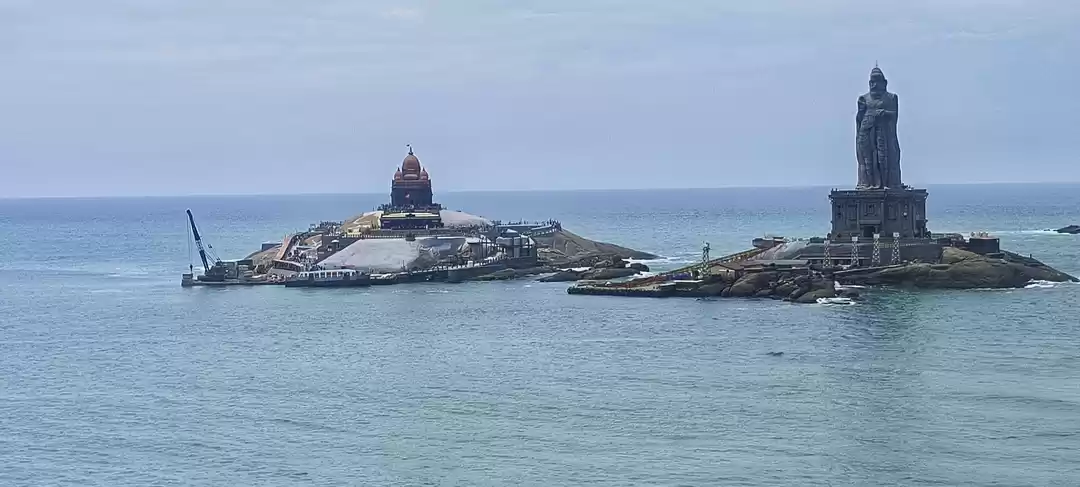Have you ever wondered what it would be like to stand at the edge of the Indian subcontinent, where the Arabian Sea, the Bay of Bengal, and the Indian Ocean meet? Have you ever imagined witnessing the sunrise and the sunset over the horizon, on the same day, from the same spot? Have you ever dreamed of visiting a place where the ancient and the modern, the natural and the man-made, the sacred and the secular, coexist in harmony?
If you answered yes to any of these questions, then you should definitely add Kanyakumari to your travel bucket list. Kanyakumari, also known as Cape Comorin, is the southernmost point of mainland India, and a popular tourist and pilgrimage destination. It is famous for its spectacular views, its serene beaches, its rich culture and history, and its diverse attractions.
One of the most prominent and impressive attractions in Kanyakumari is the Thiruvalluvar Statue, a colossal monument dedicated to the legendary Tamil poet and philosopher, Thiruvalluvar. Thiruvalluvar is the author of the Tirukkural, a classic Tamil work that deals with ethics, morality, and wisdom. The Tirukkural is considered one of the finest literary and philosophical works in the world, and has been translated into many languages.

The Thiruvalluvar Statue is a must-see for anyone who visits Kanyakumari, as it offers a glimpse into the rich and glorious heritage of Tamil Nadu, and a tribute to one of its greatest sons. In this article, we will tell you everything you need to know about the Thiruvalluvar Statue, its architecture, history, and significance, and how to plan your visit to this awe-inspiring landmark.
Architecture and History
The Thiruvalluvar Statue is a marvel of engineering and artistry, standing tall and proud on a small rocky island, about 400 meters off the coast of Kanyakumari. The statue is 133 feet high, which corresponds to the 133 chapters of the Tirukkural. It weighs about 7000 tons, and is made of concrete and stone. It was designed by the renowned sculptor Dr. V. Ganapati Sthapati, who also designed the Vivekananda Rock Memorial, another iconic attraction in Kanyakumari.
The statue depicts Thiruvalluvar holding a palm leaf manuscript of the Tirukkural, and standing on a lotus pedestal. The pedestal is 38 feet high, which represents the 38 chapters of the first section of the Tirukkural, which deals with virtue. The statue itself is divided into three sections, representing the three sections of the Tirukkural, which deal with wealth, love, and happiness. The statue also resembles the Nataraja, the dancing form of Lord Shiva, as it has 10 fingers and toes, and a ring of fire around its head.
The statue was conceived and commissioned by the Tamil Nadu government, and the then chief minister, Dr. M. Karunanidhi, who was also a Tamil scholar and admirer of Thiruvalluvar. The statue was inaugurated on January 1, 2000, by the then president of India, K. R. Narayanan. The construction of the statue faced many challenges and controversies, such as delays, protests, cyclones, and legal issues. However, it was completed with the support and cooperation of various agencies and organizations, and the dedication and skill of the workers and engineers.
Tourism and Pilgrimage
The Thiruvalluvar Statue is a popular and attractive destination for tourists and pilgrims, who flock to Kanyakumari to admire its beauty and grandeur, and to pay their respects to the revered poet and philosopher. The statue is accessible by a ferry service, which operates from 8 am to 4 pm, every day, except on Mondays. The ferry ticket costs Rs. 50 per person, and includes a visit to the Vivekananda Rock Memorial, which is located on another nearby island. The ferry ride takes about 15 minutes, and offers a scenic view of the sea and the coast.
The statue is open to visitors, who can climb up to its feet, and enjoy a panoramic view of the surroundings. The statue is also illuminated at night, creating a stunning spectacle. The best time to visit the statue is during the sunrise or the sunset, when the sky and the sea are painted in vibrant colors, and the statue glows with a divine aura.
The statue is not only a tourist attraction, but also a pilgrimage site, as it represents the spiritual and cultural values of the Tamil people, and the universal message of the Tirukkural. The Tirukkural is a masterpiece of human wisdom, that teaches the principles of righteous living, social justice, and human excellence. It is revered by people of all faiths and backgrounds, and has been praised by many eminent personalities, such as Mahatma Gandhi, Albert Schweitzer, and Leo Tolstoy.
The statue is also surrounded by other attractions and landmarks, that make Kanyakumari a unique and memorable destination. Some of these are:
The Vivekananda Rock Memorial, a monument dedicated to the great Indian monk and philosopher, Swami Vivekananda, who meditated on this rock in 1892, and attained enlightenment. The memorial consists of two structures, the Vivekananda Mandapam and the Shripada Mandapam, which house a statue of Vivekananda, a meditation hall, a museum, and a book store.
The Gandhi Memorial, a memorial dedicated to the father of the nation, Mahatma Gandhi, who visited Kanyakumari in 1925 and 1937. The memorial is built on the spot where his ashes were kept before immersion in the sea. The memorial is designed in the shape of an urn, and has a unique feature, that on October 2, his birthday, the sun’s rays fall directly on the spot where his ashes were kept.
The Kanyakumari Beach, a beautiful and serene beach, where the three seas meet. The beach is famous for its multi-colored sand, its rocky shoreline, and its spectacular views. The beach is also a great place to enjoy water sports, such as swimming, surfing, and boating.
The Kanyakumari Temple, a ancient and sacred temple, dedicated to Goddess Kanyakumari, the virgin form of Goddess Parvati. The temple is one of the 51 Shakti Peethas, where the fragments of Goddess Sati’s body fell, according to Hindu mythology. The temple is also known for its exquisite architecture, its diamond nose ring, and its annual festivals.
Conclusion
The Thiruvalluvar Statue is a magnificent and majestic monument, that stands as a testimony to the genius and glory of Thiruvalluvar, and the Tirukkural. It is a must-visit for anyone who wants to experience the beauty and diversity of Kanyakumari, and the culture and heritage of Tamil Nadu. It is a place where you can learn, admire, and be inspired by the timeless wisdom and values of the Tamil poet and philosopher, and the universal message of the Tirukkural.



























